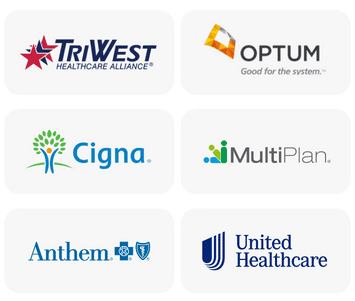Outpatient programs often include a blend of group and individual therapy. They may also offer both traditional and alternative therapies in a comprehensive approach to addiction treatment.
Types of Therapies in Outpatient Rehab
The National Institute on Drug Abuse (NIDA) says that behavioral therapies are the most regularly used type of addiction treatment in the United States.
Therapy is the core of addiction treatment and will be included in virtually all programs, including outpatient addiction rehab. The type of therapy you will receive depends on where you get treatment and what you need.
The following are examples of therapies commonly offer through outpatient addiction treatment:
- Group therapy
- Individual therapy
- Family therapy
- Cognitive behavioral therapy (CBT)
- Alternative therapies, like expressive therapy, experiential therapy, or ecotherapy
- Trauma therapies, like EMDR (eye movement desensitization and reprocessing)
Traditional vs. Alternative
One of the most common types of traditional therapy for addiction treatment is cognitive behavioral therapy, or CBT.
Behavioral therapies help you recognize behaviors and thoughts that are problematic and where they come from, so you can work to change them for the better. These therapies can be offered in both group and individual settings, and they encourage positive change.
The journal Psychiatric Clinics of North America reports that CBT can be highly beneficial in addiction treatment. CBT will often include talking through personal issues with individual sessions and learning new coping strategies and tools through life skills training and group therapy sessions.
Alternative therapies are often used in conjunction with traditional therapies to provide different outlets and forms of expression rather than just talking.
Alternative therapies can include the following expressive and experiential forms:
- Yoga
- Tai chi
- Art
- Comedy
- Music
- Role-playing and acting
- Animal care
- Ecotherapy (building a garden)
Alternative therapies often include movement or an activity as a form of expression and a positive outlet to work through feelings and emotions.

Individual vs. Group Sessions
Both group and individual therapy sessions are important during outpatient addiction treatment. They complement each other and develop a different set of skills and resources.
During individual therapy sessions, you can work through the root causes of your drug abuse. You’ll discuss personal triggers, problematic patterns of thinking and related negative behaviors, as well as any other issues that are specific to what you are going through.
A lot of growth and personal discovery can also happen in group therapy, which is led by a therapist. Group therapies can help you to feel less alone, and they provide you with encouragement and resources from peers who are also experiencing similar things.
Group therapy sessions will often have a skills training or therapeutic topic for the session that all participants work on together. It can be helpful to hear what your peers in recovery are doing to cope in recovery, and a directed group therapy session offers more direction and control than peer support group meetings.
Another form of group type therapy is family therapy. This can include all members of your family, and sessions can improve the way you guys talk to each other and interact. This can bolster the family unit, and it can enhance communication and problem-solving skills for all family members.
Your family is key to your overall recovery. Family therapy sessions can help you all work together to heal.

How Much Is Included?
The question of how much therapy is included in your outpatient program depends on the program you are enrolled in and the level of care.
There are three main levels of outpatient treatment:
- Traditional outpatient programs
- Intensive outpatient programs (IOPs)
- Partial hospitalization programs (PHPs).
PHPs are the most structured form, with the highest number of hours and services provided. In a PHP, you will generally get the most time in therapy of all outpatient programs.
Daily
Usually, most outpatient treatment programs will include both group and individual therapies, and many include family therapy as well. Sessions are typically 60 to 90 minutes. They may be offered once a week, a few times a week, or every day, depending on your treatment plan and level of care.
The Substance Abuse and Mental Health Services Administration (SAMHSA) publishes the following general schedule for an IOP, which usually has sessions three hours a day for three days per week:
- Days 1 and 2
- 90-minute group session with peers in same stage of treatment
- 90-minute group session based on a specific topic or skills training
- Day 3
- 30-minute individual therapy session
- 90-minute family therapy session
- 60-minute life skills training session, usually in a group therapy setting
A PHP will have more sessions and more hours each day — usually six hours per day five days per week. A traditional outpatient program may run a few days per week and include one, two, or three sessions. These sessions may include a combination of family, group, and individual therapies.
Overall
The amount of therapy you get overall is tailored to you specifically. If you stay in a program for longer, you will get more therapy sessions than a shorter program. In general, the National Institute on Drug Abuse (NIDA) recommends staying in an addiction treatment program for at least 90 days.
Your insurance may play a role here too. Coverage may outline a certain number of therapy sessions or a set number of days in a treatment program. Limits are typically set up on a calendar year basis, but some plans may have lifetime therapy or addiction treatment limits.
Check with your insurance provider directly to figure out exactly how much therapy is included in your plan and the amount of services that will be covered.
Which Should I Seek Out?
Again, almost all outpatient treatment programs will offer some form of group and individual behavioral therapies. These are considered the gold standard in addiction treatment.
Your treatment plan should be specific to you, and it should change as you grow in recovery. Other therapies you may wish to explore include:
- Trauma therapy. If you have experienced trauma, a specialized therapy called EMDR can help you to release emotions and work through difficult memories. This therapy aims to help you process traumatic events from your past in order to heal and view them in a new and different way.The EMDR Institute explains that this form of therapy combines different techniques to improve overall functioning. EMDR is particularly helpful for people who suffer from PTSD (post-traumatic stress disorder). Complex trauma therapy groups can be helpful for this issue as well.Mental illness and addiction often co-occur. Integrated therapies can be highly beneficial in treating both disorders at the same time.
- Expressive and alternative therapies. Expressive therapies that allow you to create something or move in a certain way can be an alternative method to help you better understand yourself, your emotions, and your thought patterns. You can get in touch with yourself in a different way and learn to recognize how your feelings are complexly intertwined with your actions.These therapies are best used as adjunctive forms of therapy. They should not substitute for traditional therapies, but they can be used to enhance recovery in an outpatient addiction treatment program.
The best way to know how much therapy you need is to get a complete evaluation and assessment from a trained professional. Treatment providers can then design a plan that is ideal for you.
Questions about treatment options?
Our admissions team is available 24/7 to listen to your story and help you get started with the next steps.

